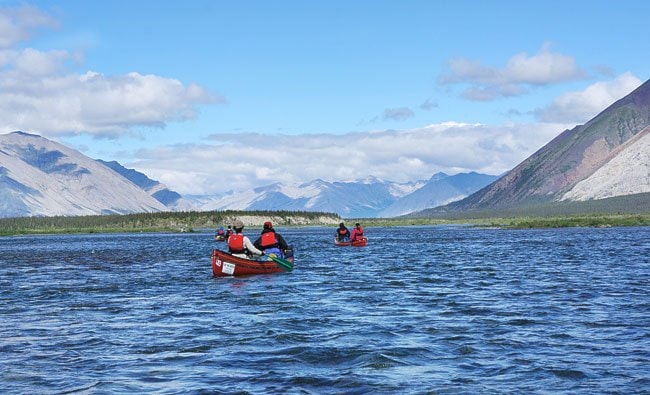How deeply can you care about a place you’ve never seen? How badly will you fight to protect mountains you’ve never climbed and rivers you’ve never paddled?
Questions like these were part of what inspired five First Nations youth to spend 18 days paddling down the Wind and Peel rivers, getting to see the Peel watershed first-hand.
The group flew from Mayo to the Wind River in a float plane on July 7 and arrived in Fort McPherson, N.W.T. at the end of their trip on July 24. The expedition was organized by the Yukon chapter of the Canadian Parks and Wilderness Society. It took place one month before the Yukon government is slated to appeal the Yukon Supreme Court’s decision to strike down its land use plan for the watershed, which would open up 71 per cent of the region to mineral staking.
“It’s reaffirmed my belief in why I want to see this place protected,” said Geri Lee Buyck, a 24-year-old from the First Nation of Nacho Nyak Dun, in Mayo. “It’s always going to be in the back of my mind now. I feel like I’m devoted.”
This trip was no small challenge for Buyck. She’d spent a few days in the Peel region before, but she’d never attempted a trip of this length, and she’d never done much canoeing.
“This trip was definitely out of my comfort zone,” she said. “I would say that I was the least experienced out of the females for sure.
“My sister said I came back with bigger pipes,” she added with a laugh.
Sarah Newton, who coordinated the trip for CPAWS, said she wasn’t looking for youths with lots of outdoor experience. Eleven young people applied from communities in Yukon and the Northwest Territories located in and around the Peel watershed. Newton said they had to answer questions about the leadership roles they take in their communities. They also had to talk to an elder about the importance of the Peel region as part of their application.
She said most of the youths they chose were strong leaders, even if they hadn’t spent much time in a canoe. Buyck, for instance, has attended many events to show support for the Peel. She also works as a supervisor at the Peel Visitor Centre in Mayo, giving information to tourists about the region.
The other participants were Dana Tizya-Tram of the Vuntut Gwitchin in Old Crow, Bobbi Rose Koe of the Tetlit Gwich’in in Fort McPherson, Robert Neyando of the Gwichya Gwich’in in Tsiigehtchic, and Prairie Dawn Edwards of the Ehdiitat Gwich’in in Aklavik.
Newton said they spent most days either canoeing or hiking in the mountains by the river. The days were physically exhausting, but she said the group pulled together to keep everyone’s spirits high.
She remembered an especially difficult day, when the group went for a 10-hour hike up a steep mountain. Every time they thought they were close to the top, another stretch would open up above them.
“A couple of the participants were really starting to feel really challenged by this hike,” she said. Finally, they said they wanted to stay behind, but the rest of the group pushed them to keep going.
“We all pulled together, and we all made it to the top of that mountain,” she said. “I was just really proud of the whole group.”
Buyck said the landscape was so beautiful that it was hard to describe.
“It’s just so sublime. There’s just no words,” she said. “The area, the water, and the landscape are just so stunning and surreal. I kept saying to myself every day, we don’t have to fly halfway across the world or down to the Bahamas to experience this. It’s in our own backyard.”
She said they saw black bears, moose, caribou, and sheep that came right up to them, unafraid. They also caught and ate a grayling for supper one night.
After spending 18 days in the wilderness, Buyck said it was a bit strange to find herself back in Mayo.
“I noticed myself looking around at people and vehicles and whatnot,” she said. “You just notice everyone’s busy being busy. It just made me instantly wish that I was back there. Out there it’s so peaceful.”
Newton said this trip was especially important because few people from the communities are able to get out to remote areas of the Peel region.
“Right now, it’s very expensive to get in there,” she said. “It’s hard for people from the communities to take the time or have the money. If you have the time, you don’t have the money, and if you have the money, you don’t have the time.”
Buyck said she wants to help other people get out to see the Peel, both locals and tourists. She’s planning to study business management somewhere in B.C., and hopes to work in ecotourism. She’d like to see more people from her community trained to work as guides in the watershed. If more people can see the area, she hopes, more people will want to protect it.
“I’ve always been kind of searching or wondering about standing up for something that’s bigger and greater than myself,” she said. “Being out there, I’ve come to the realization that it’s the Peel. I really want to see this place protected.”
The Yukon government will appeal the Yukon Supreme Court’s decision on the Peel watershed land use plan on Aug. 20 and 21.
Contact Maura Forrest at
maura.forrest@yukon-news.com
